Ferrari 312 (1968)
In the 1967 season, Forghieri makes several modifications to the 312 F1 model. The main one is the fiberglass bodywork, which reduces the overall weight of the car from 600 to 530 kg. By working on the engine, the power increases first to 390 hp and subsequently, with the adoption of the 48-valve cylinder head, to 410 hp.
For 1968, the third season of use, Forghieri and his team primarily focus on the aerodynamics of the 312 F1, modifying the nose and bodywork. But the big innovation is the introduction of the rear wing, destined to set a trend and remain as a symbol of one of Mauro Forghieri’s major contributions to the world of Formula 1.

Drivers:
Jacky Ickx: In his first full season in Formula 1, the young Belgian driver immediately reveals his extraordinary talents. After two retirements in the first two races of the year, Ickx steps onto the podium three times, finishing third at Spa, Brands Hatch, and Monza, and on the top step at the French Grand Prix, where he brings the rear wing to its first victory. At the end of the season, he ranks fourth in the World Championship standings.
Chris Amon: Enzo Ferrari thinks he has found in the New Zealand driver a contender for the world title. But he didn’t reckon with a bad luck that would become proverbial and wouldn’t allow Chris to win a single Formula 1 race. In 1968, Amon achieves only one notable result, a second-place finish in the British Grand Prix at Brands Hatch.
Andrea de Adamich: Behind the wheel of the 312 F1, the Italian driver competes in his only Formula 1 race for Ferrari in South Africa. He retires after thirteen laps.
Derek Bell: Bell makes his Formula 1 debut at Monza with the 312 F1. The race ends in retirement, as does the subsequent United States Grand Prix at Watkins Glen.
Our model cars:

The rear wing makes its debut at Spa, in the 1968 Belgian Grand Prix. Through a hydraulic control, the driver can manually adjust the angle of the wing according to the need. In its third outing, at the French Grand Prix at Rouen, it immediately proves successful. It marks the third and final victory in its history for the 312 F1.


